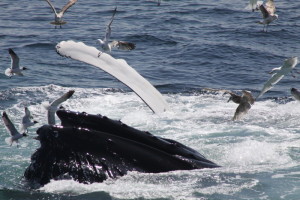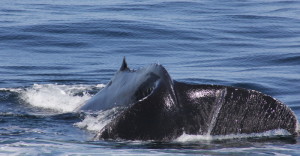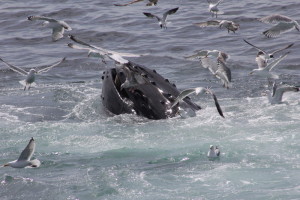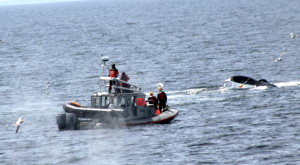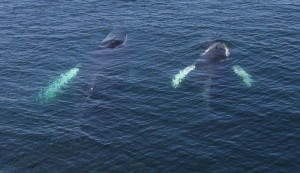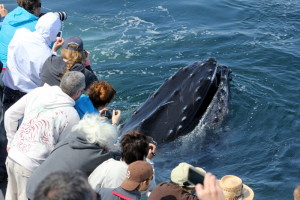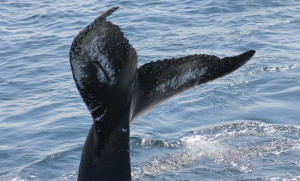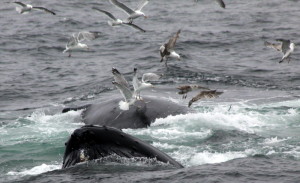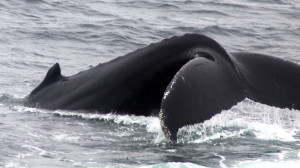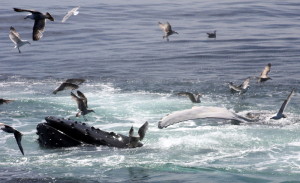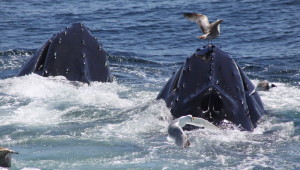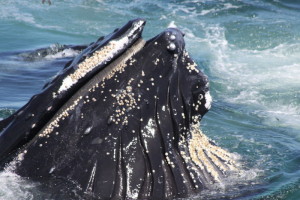Naturalist Notebook – May 17 to May 23
May 17 was a crisp, cool morning, and our spotters were especially chilly standing on the fly bridge watching for spouts as we approached the southwest corner of Stellwagen Bank. When we arrived, we counted at least 15 humpback whales. It looked as though they were spending more time moving around looking for food than they were actually eating. Still, we got to witness various feeding behaviors, including bubble columns, kick feeding and dragging.
Even with all the feeding excitement, the clear highlight of the trip was a sudden chin breach from a humpback with a white patch by its right eye.
The excitement continued well into the afternoon, and when we approached the southwest corner in the afternoon, there were whales as far as they eye could see, especially to the north and west. We had three species of whale, humpbacks, fin whales and Minkes, all at the southern edge of the bank. Etch-a-Sketch, a humpback, was using its tail to drive fish to the surface and stunning them, and the whale feeding alongside Etch-a-Sketch would periodically roll over, allowing spectacular looks at the extended rorqual pleats on the underside of its body.
Whales weren’t the only one taking advantage of the bounty of Stellwagen Bank. At one point, we came across a Harbor seal who had caught itself a large fish!
Bright skies and a “catspaw” sea made it easy to find the large number of whales feeding on the southwest corner again on May 18th. One feeding group contained seven humpbacks, and in another feeding group we saw a female humpback, Cardhu, for the first time this year and discovered that she had a calf with her!
However, the two whales that we spotted heading west consumed our attention and our time. Basmati, a humpback accompanied by her calf, was spotted trailing fishing gear. These two had separated themselves from the feeding group, and upon closer inspection, we observed that two lobster pot buoys and some additional line were trailing from her left fluke!
Entanglement in fishing gear is a leading cause of death for large whales in our area. An entangled whale accompanied by a calf is an especially dangerous situation because during the frequent close contact a calf has with its mother, it could potentially become entangled as well! Accordingly, we called the disentanglement team at the Provincetown Center for Coastal Studies. This team is specially trained to disentangle whales and turtles. They also conduct research to learn more about how these entanglements can be prevented. Learn more about what they do here.
We stood by with Basmati and her calf, as it is very challenging for a vessel to relocate an entangled animal without another vessel’s help. After waiting for what seemed like a long time, the R/V Ibis finally arrived and we had to head home. We were really relieved to learn later that the team successfully removed the gear from Basmati, and she was spotted gear-free in the following days!
Feeding, breaching, and loads of birds contributed to the excitement on May 19th. In the morning, we watched Cardhu and her calf breach over and over again, the calf occasionally spy hopping to get a better look at what was going on above the surface. We’ve been watching Cardhu on Stellwagen Bank since 1981. This is the twelfth calf she’s had since then!
More mom/calf pairs graced the scene, including Rapier and her calf and Pisces and her calf. Notice that Pisces’ calf is covered with many scratches — many of these are from rubbing up against its barnacle-encrusted mom!
Pisces and her calf were a little bit more subdued than the energetic Cardhu and calf today. They swam along the surface, going on leisurely dives, spreading their long white flippers before sounding.
By mid-day, feeding activity picked up again and we noticed huge schools of sand eels being consumed by the thousands by kick feeding and bubble feeding humpbacks. Swooping down into the feeding frenzy were many gulls, terns, as well as several types of shearwaters. Sooty shearwaters have some of the longest migratory routes of any animal on the planet, and it is always an exciting sign of summer to see them return to our waters to feed on the same fish the whales are after!
The feeding frenzy we witnessed on May 20th can only be described as over the top! We had bubble nets encircling the bowsprit like a halo. Whales would emerge right off the bow, then split off down either side of the boat, dragging, pushing water from their mouths before swallowing their prey whole.
Accompanying us out to the bank was our friends at Sea Salt Charters. This company offers private whale watches on a small vessel and is run by the same family that started the Dolphin Fleet, and whale watching on the east coast! There were three mother and calf pairs, including Rapier and calf, Cardhu and calf, and Mural and calf. One calf was breaching, rolling, and flipper slapping.
Rapier
By the afternoon, the feeding continued, but it had slowed down a bit. Slow, lazy bubble nets formed occasionally, and whales continued to munch away through the sand lance near the surface.
Fog of varying thickness covered the southern end of Stellwagen Bank on May 21st, obscuring any activity that was going on out there. After a great deal of time spent straining our eyes in the fog and staying perfectly quiet so we could listen for spouts, a humpback was finally located. Unfortunately, it was not the most cooperative humpback. It spouted twice and then sunk without fluking.
As we waited for this whale to surface again, we got a surprise! As many as a half dozen Minke whales took turns popping up around the boat, giving the passengers much better than normal looks at them. We were able to spot two other humpbacks, but upon observation, they were found to be spending even less time at the surface than the last one. So rather than waiting for two to pop up, we spent our time getting great looks at the normally elusive Minkes!
The fog and mist continued on into May 22, but the rain took a pause for us and we were able to find humpbacks who were more cooperative (and hungrier) than the ones from the day before. We located a group of twelve, ravenous, bubble feeding humpbacks, all chowing down on a mass of sand eels.
Wizard, A-Plus, Midnight, Scylla’s 2008 calf, and Etch-a-Sketch were among the feeding whales, and as we watched this group feed away, Minke whales cut in and among the larger animals, obviously after the same school of fish.
Birders were also able to spot a parasitic jaeger — always an exciting find! This large, gull-like bird is famous for its behavior of kleptoparasitism. It will chase and harass other birds until they drop any fish they have caught, stealing the prey before it hits the surface of the water!
We left the dock on May 23rd with a layer of thick fog over Provincetown. We could barely see the Pilgrim Monument from the pier, and we anticipated having another long search in Stellwagen Bank.
Fortunately, the fog soon lifted and we found that the group of feeding humpbacks at the the southern edge of Stellwagen Bank had persisted. At least a dozen humpbacks, including Convict, Music, Eruption and Circus blew bubble nets repeatedly until it looked like the sea was boiling.
Everywhere we looked, humpback heads emerged from bubble clouds, revealing mouthfuls of food. Humpback whales belong to a group of whales known as the rorquals, meaning that they flexible pleats on the undersides of their bodies which expand when they engulf a mouthful of fish or krill. The musculature of these pleats help the whale to push water out between their baleen plates as they swallow their prey whole.
Bird enthusiasts had another successful day out on the water. The calm seas allowed us to spot a small group of phalaropes. These little birds are planktivores, meaning they feed on zooplankton. They spin in circles to aggregate the plankton at the surface before plucking it up with their beaks. Interestingly enough, individual phaloropes will either spin clockwise or counter clockwise, but they never switch directions!






